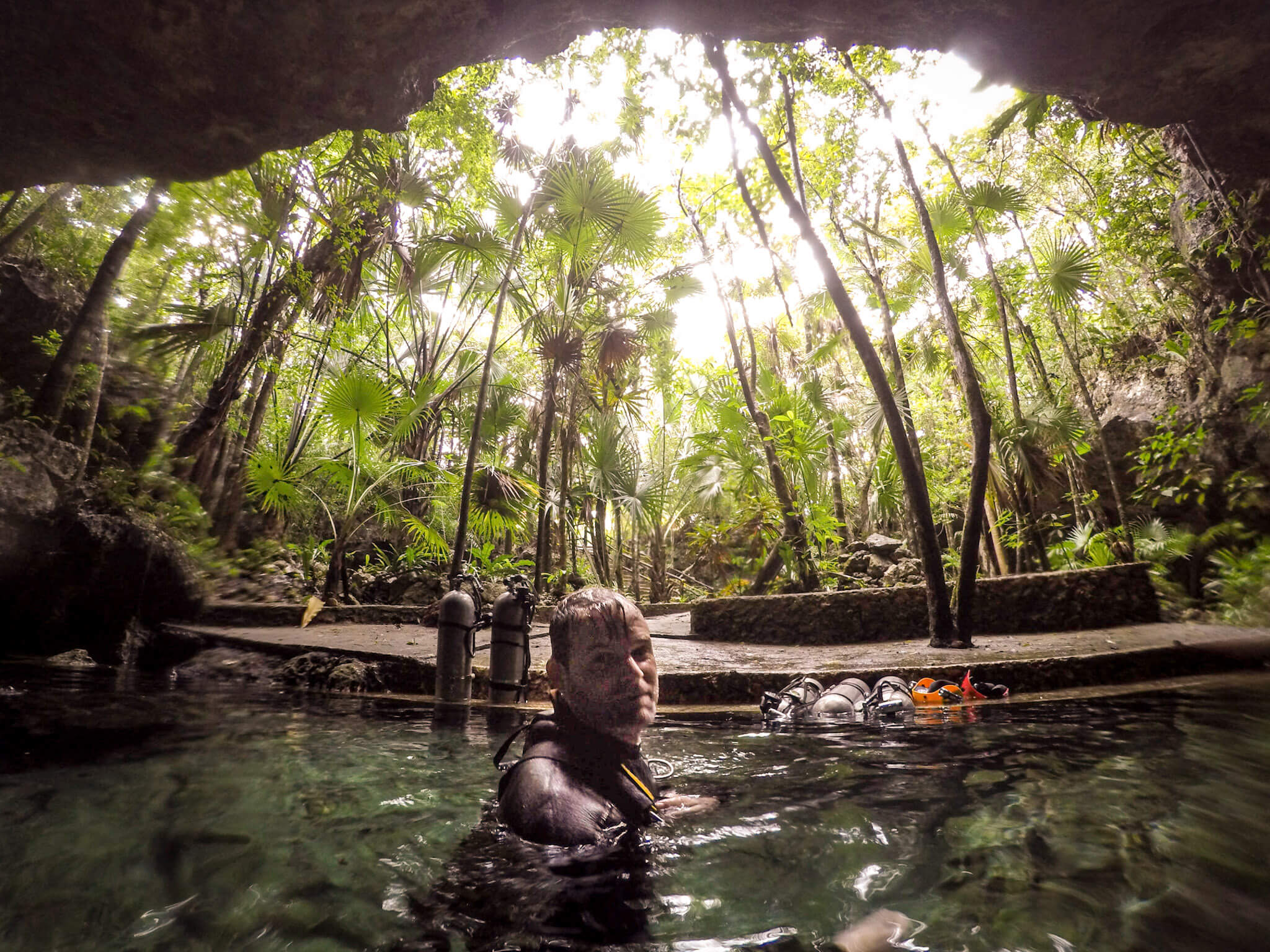A cenote is a natural pit or sinkhole, resulting from the collapse of limestone bedrock that exposes groundwater, found throughout the Yucatán Peninsula in Mexico. Some are large, open-water pools while others are small cracks in the earth. The cenotes were the water source for the ancient Maya; today they’re a popular tourist attraction for swimmers, snorkelers, and scuba divers. And there are options for scuba diving in cenotes for all levels of certified divers. I’ll explain the different options and what to consider.
Contents
Why scuba dive in cenotes?
Cenotes are magical places. Found in the middle of lush jungle, these openings in the earth reveal crystal clear water, filtered by the limestone bedrock. They are decorated with stalactites and other geological features. Who wouldn’t want to explore what the cenotes hide under the surface of the water, and go where few people have ever gone.



The Yucatán Peninsula has an estimated 10,000 cenotes. The cenotes in Quintana Roo, between Playa del Carmen and Tulum, are interconnected by a vast underwater cave system. The two major cave systems in the area are the longest underwater cave networks in the world. If we compare them to dry cave networks, there is only one dry cave system that is larger.
The Sistema Ox Bel Ha network includes 435 kilometres of surveyed tunnels, connecting some 150 cenotes (as of 2023… explorers are still finding new tunnels).
Sistema Sac Actun has 386 kilometres of tunnels and over 200 cenotes (as of 2023). It had previously only 230 kilometres until 2011 when a connection was found with Sistema Aktun Hu (gaining some 30 kilometres), and then grew to its current size in 2018 with the discovery of a link between the Sac Actun system and the Dos Ojos system.


Scuba diving in overhead environments: cavern vs. cave
Scuba diving in the cenotes usually involves penetrating the cavern system, so unlike open water diving, you’re in an overhead environment. It’s important to differentiate cavern diving from cave diving.
Cavern diving is a dive within the light zone of a cave: the part that is illuminated by natural light (from the cenotes). Cavern dives are also restricted to 40 metres from the surface, including both vertical and horizontal distances. Diving beyond the light zone is cave diving. Luckily, because of the interconnected network of cenotes, we can find very large cavern zones illuminated by multiple cenotes, like the cavern at Cenotes Dos Ojos.

Guided cavern diving
Guided cavern diving is open to any certified open water diver with good diving skills. Emphasis on “guided”: diving in an overhead environment is beyond the training of open water divers, so you need to be with a qualified guide. You need to be comfortable in the more confined environment of the cavern, and your buoyancy and trim need to be good so that you don’t stir up silt and reduce visibility, or damage the fragile geological features.
You will be diving in the cavern with a certified guide who holds at least a Divemaster and Cave Diver rating, but will often be an instructor. They’ll provide a thorough briefing on the cavern environment and the additional safety consideration, which should be taken seriously. If you have your advanced open water certification, it will open the door to some more advanced and interesting caverns.
Since the cave network in Mexico is relatively shallow (often only 5-6 metres deep, sometimes 7-9 metres), so dives can be longer than we’re used to in open water.
Cavern diving definitely isn’t for all people. But if you’re remotely intrigued by this, it’s definitely worth it!

Organizing a cavern diving vacation
Cavern diving is accessible from a few popular tourist locations in the Yucatán Peninsula. Most of the cenotes accessible to diving are located between Playa del Carmen and Tulum (more specifically, between Puerto Aventuras and Tulum).
There are several dive shops in both Playa del Carmen and Tulum that offer guided cavern dives. They all offer equipment rentals, and most shops include transportation from the dive shop to the cenotes. Your guide will set you up with your rental equipment, drive you to the cenote, sort out the entrance fees, provide a thorough briefing tailored to the specific cenote, and safely guide you through the cavern while pointing out features of interest.
While Playa del Carmen is slightly further from the cenotes, they’re still only a 30-45 minute drive away. Stay here if you want the restaurants, bars and nightlife that Playa del Carmen offers.
If you want a more chill experience, stay in Tulum. You still have plenty of great restaurants in Tulum, and you’ll be a shorter drive from the cenotes.
You could also stay at any resort along the Riviera Maya. Some shops may pick you up at your hotel, while others will require that you arrange your own transportation to the dive shop.
If you’re thinking about a dive vacation to Cozumel, most dive shops in Cozumel provide ocean diving packages that include a day trip to the mainland for cenote diving.
Cavern Diver certification
If you’ve already tried guided cavern dives, or perhaps you want a more in-depth experience, you can consider taking a Cavern Diver certification course. Depending on the training agency and dive centre, the Cavern Diver course is taught over 2 to 4 days. With this certification, you will be qualified to engage in cavern diving without a guide (still adhering to the limits of your training), and you’ll have the prerequisite enrol in a cave diving course.
Learn more about what’s involved in the Cavern Diver course, and continuing on to the Intro to Cave and Full cave courses.

Leave a Reply